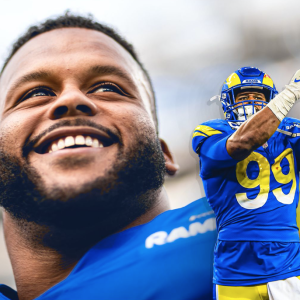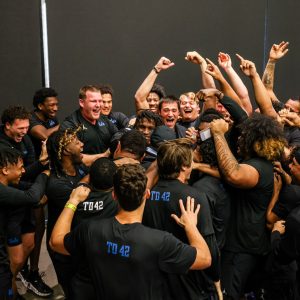 View Winners →
View Winners → 
David Marquez watched his twin daughters prepare to play in a showcase softball game in 2020. Looking into the stands and noticing the college recruiters made him emotional.
Just a few months before, this reality didn’t seem possible.
Seven months prior in March, Alyssa and Bryanna Marquez — who both play for Alverno Heights Academy’s softball program — needed to adjust to remote learning and restricted gameplay.
Their softball season ended after a 5-1-1 start, and during the summer they couldn’t meet with their travel ball teams. When the fall semester arrived and they still couldn’t return to campus, the hope of a volleyball or basketball season (two sports they both play) crashed and burned.
Zoom learning created a challenging atmosphere for Marquez’s girls. Although he clarified that “one’s an introvert and the other’s an extrovert,” both were very social when they were competing. Even as freshmen in 2019, they had already built bonds in all three sports programs.
“I could tell how hard it was on them,” said Marquez, who is also the assistant softball coach at Alverno Heights. “Even when they could play, they couldn’t even touch each other. One of my daughters is very nurturing, and she would love to hug her teammates and celebrate after a great play. And she was having a super hard time even when she got back on the field ‘cause restrictions still wouldn’t allow her to do that.”
Yet, here they were in early December 2020, finally playing, trying to get eyes on them for the opportunity to earn a scholarship.
And even if that opportunity slipped away, both Alyssa and Bryanna excelled academically, regardless of the difficulties that remote learning created. They were prepared to use their grades as a means to enter college rather than their athletic abilities.
Several student-athletes, however, could not replicate the Marquez sisters’ adaptability.
Student-athletics and mental health
In the midst of COVID-19 dismantling young adults’ everyday schedules and lives, student-athletes were one subgroup of the demographic who faced insurmountable challenges in regard to their mental health.
A study published in the International Journal of Environmental Research and Public Health interviewed students multiple times a week during the remote learning period. Results showed that out of the 20 subjects involved, nearly every single one reported that their mental health worsened at the onset of restrictions.
A big reason for that was the inability to use physical activity as a way to cope with their emotional well-being. The sudden transition to being locked inside, along with a mass issue of losing easy access to workout equipment, created a lack of space to prioritize physical health. And as the remote experience continued, it became even more of a challenge for these same kids to stay motivated.
“Participant 20-M explained how the onset of restrictions ‘affected me mentally because I was used to putting all my energy into a sport, but then suddenly I didn’t have anywhere to put that energy… it just made me feel very um, impatient or like, um, restless,’” the aforementioned study said in regards to one of the subjects interviewed.
Restlessness often turned to frustration, enough to where several athletes felt the need to turn their backs on the sport they loved. Several coaches across all sports throughout Southern California reported that their rosters dropped significantly during the pandemic, including San Marcos football head coach Joe Jones who told Hey SoCal in 2021 that his kids were “falling off by the dozens.”
Yet studies and statistics are sometimes not needed to comprehend the damage this new reality had on high schoolers. For several people, the eye test was all that was needed.
In November 2020, longtime Culver City assistant football coach Greg Goodyear noticed the difficulty of that transition right away. During Zoom meetings, in which players were set up in their rooms, he couldn’t take his eyes off of all the kid’s unmade beds — it was a harsh reality for him that they were stuck in a psychologically grueling cycle.
“Obviously there was a mixed bag of emotions when things were shut down, some kids thrived and some kids really struggled,” he said. “But truly I connected and sympathized deeper with the kids who faced the tougher challenges during that time. It was hard for basically everyone in our program.”
Goodyear had personal reasons to feel worried once the pandemic shut everything down. In regards to his own health, Goodyear was diagnosed with a severe case of prostate cancer in November 2014. At that time, he was told by doctors that he had five years to live. Five and a half years later he remained a vital part of Culver City’s football program.
Working closely with the roster’s quarterbacks, Goodyear was paramount in the development of many, including Jonathan Martin. Martin became the starting quarterback for the Centaurs his freshman year, which was also the first year Goodyear came back to the program after the news of his cancer.
It would only be the beginning for one of Culver City’s most memorable players over the past decade. Martin finished his high school career with two 1st Team All-CIF selections, throwing 103 touchdowns, averaging nearly 300 passing yards per game, and helping bring home two Ocean League championships.
Once Martin attended Cerritos College, Goodyear was preparing to transition Zevi Eckhaus into that play-calling role. The transition proved to be smooth during the 2019-20 season when Culver City finished with a 12-1 record — including a perfect 5-0 in league play. Yet COVID-19 struck, and it flipped Goodyear’s world upside down.
When the recruiting and training period resumed for the program during COVID, coaches and the school’s athletic department warned against him participating in team activities in fear of someone with his stage of cancer contracting the virus. He was restricted to be out on the field with the kids that he deeply loved to mentor.
It completely crushed him. His biggest passion was taken from him, but when it returned he mainly spent his time watching on the sidelines.
His long-standing battle with cancer ended last year in early December. We only spoke once, but his heart for not only football, but the young men who played it, leads me to believe this — one of the last wishes in his life was for the kids he coached to find joy on the field again.
Eventually, that love would be found again. Culver City’s football program and nearly every high school athletic program across California had a season in 2021. Were things different? Absolutely. Did teammates lose that special connection that makes the athletic experience so worthwhile due to COVID restrictions? Again, absolutely. But during that time, the love of actually competing needed to help heal the sting that was brought by those hardships.
Even currently, despite the outside world still facing an uphill battle against the virus, the county’s restrictions are beginning to allow teams to feel normal once again.
Eventually, in-person competition may return to the same dynamic Goodyear embraced with his players throughout his life.
How the shutdown impacted collegiate scholarships
Nevertheless, when looking at the longstanding impact that this period of time had on high school athletics, one element that might never be the same are scholarship opportunities.
Colleges all over the country lost money in 2020. The lack of activity on campuses took a tremendous toll on revenue. Remote learning led to more and more students quitting on their education. Even more than that, colleges found themselves facing several different expenses that were a result of COVID-19.
In March 2021, the National Conference of State Legislatures reported some of those expenses — refunds issued to students, increased cleaning costs and a constantly evolving technology cost to maintain an easy-to-use Zoom-based educational format.
“Due to these expenses, several colleges and universities have announced hiring freezes for faculty and pay cuts or furloughs for staff,” the study said. “Concerns about adjunct and part-time faculty, who make up more than 40% of faculty nationwide, have also emerged. Nearly all adjunct faculty lack paid sick leave and few receive health insurance from their college.”
These difficult financial realities challenged every aspect of the college experience, and one of the first subcategories to feel the pressure was athletic administrations.
For several college campuses, sports are one of the biggest pathways toward gathering revenue. According to a study from the National Collegiate Athletic Association, NCAA programs brought in an accumulative total of $18.8 billion dollars in 2019.
In contrast, with the cancellation of the association’s men’s basketball tournament, its earnings took a massive hit in 2020. The NCAA distributed only $246 million to its member schools in 2020, compared to $613 million in 2021, according to the organization’s financial records.
Just like high school athletics, college athletics were forced to stop competing throughout that lost year. However, when states and counties across the country began to allow athletics again, a majority of campuses were still unable to meet in person. This resulted in multiple programs looking for players to fill their rosters with limited income.
“Schools were still handing out scholarships, it just wasn’t as practical and easy to come by,” said Brandon Hoffman, the national recruiting editor for 247Sports. “No longer was it ‘okay, we’re gonna offer a kid because we need this spot filled.’ It turned into a competitive evaluation where you needed to convince recruiters to get their eyes on you. And those recruiters mainly did that through the transfer portal since those players normally had high school and senior film. That resulted in a lot of kids never being seen.”
Hoffman referenced Edison High School football player Devan Thompkins. As a junior, his commitment was to basketball. Yet one year later, he decided to play football for the first time in seven years — since he was 10 years old. Once the season ended, the edge pass rusher had 14 scholarship offers. He signed with USC, rejecting offers from the University of Washington and the University of Nevada, Reno.
Thompkins’ story — one that makes high school athletics exciting and special for young athletes — is the type of story that became impossible by 2020. Players who found their passion for a new sport during quarantine, or for those who just ended up being late bloomers, heading to a tryout at their city’s nearest junior college was the only hope of keeping their collegiate dreams alive.
And even in the so-called post-pandemic world, these sorts of stories are still harder to come by.
“During this new age of the recruitment process, it has never been easier to market yourself as a player and competitor. But in a lot of ways that element makes it more challenging for some student-athletes,” Hoffman said. “The pandemic proved that the process could become remote. Recruiters no longer needed to come to travel to schools and watch student-athletes play. Some kids have the edge there because their natural gifts are easily seen on film, but there are plenty whose abilities aren’t as appealing without those sets of eyes physically on them.”
What are the potential long-term effects for recruiting?
The question that arises from this observation is will this trend of college recruitment exist five to ten years down the line? Or perhaps, the other angle should be this, will a complete shift towards faraway recruiting end up helping the student-athlete that so often gets passed over?
Certainly, that possibility may create a quicker and more competitive recruiting cycle that may leave the so-called late bloomers left behind — with the likelihood of a great run-blocking wideout receiving an offer over the athletically-gifted playmaker becoming even smaller than it was prior. But marketability suddenly presents itself with unlimited potential. If remote recruiting does become the new norm, student-athletes would be capable of highlighting their athletic strengths to college programs more than they had ever done before, hoping that one of their dream universities will view their asset as a foundational fit.
Yet, that freedom of marketability does cause some concern, particularly when dealing with trust. Programs and their staff need to be cautious of the possibility of athletes being dishonest about their physical traits such as height and weight, which regularly occurred during quarantine, according to Hoffman.
However — while frowned upon — can we truly blame those kids? Those teenagers who had the pressure of their future weighing on them in the midst of all the physical and psychological turmoil from COVID?
Sadly, the uncertainty of the future of high school athletics remains as college programs enter a stalemate. The unfortunate truth, however, is that this waiting game needed to come immediately after the hardest stretch of months that high school athletes had ever experienced before.
All they can hope for now is that the wait will eventually be worth it. That this stretch will not be as mentally grueling and disappointing. That, for the first time in two years, the love of competition will hold priority over everything else happening outside of that bubble.
Check out the first two stories of the “Empty Bleachers” series:












































































































